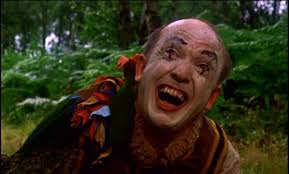My work is rarely to-the-minute, and I rarely consider when a piece will be read. I started this post long before Covid-19 and the consequent postponing of the baseball season. If it doesn't elevate, nor replace peanuts and Cracker Jack, it is, I hope, of interest.
 Over the winter, news of an actual MLB game to be played at the location for 1989's Field of Dreams (left) summoned one of the all-time film flubs: Shoeless Joe Jackson hitting right-handed. Ray Liotta, playing Jackson, failed badly to hit left-handed despite pro coaches on set (per this New York Post interview). Finally, Liotta was given permission to switch sides. It doesn't explain why the filmmakers didn't prioritize accuracy from the start.
Over the winter, news of an actual MLB game to be played at the location for 1989's Field of Dreams (left) summoned one of the all-time film flubs: Shoeless Joe Jackson hitting right-handed. Ray Liotta, playing Jackson, failed badly to hit left-handed despite pro coaches on set (per this New York Post interview). Finally, Liotta was given permission to switch sides. It doesn't explain why the filmmakers didn't prioritize accuracy from the start.The 1919 White Sox added disgrace to poverty when they threw the World Series. 70 years on, the "Black Sox" were in the zeitgeist: 1988's Eight Men Out had D.B. Sweeney as Jackson. According to MLB Radio's Ryan Spilborghs (in a special devoted to Bull Durham), the athletic motions in Eight Men Out are "terrible." Even so, that Joe Jackson hit lefty, at least. Filmmaking is tough, but faking a base hit is still easier than the real skill (hitting a round ball with a round bat). Faking is Hollywood's job.
 |
| Shoeless Joe Jackson |
It's not that Ray Liotta was perfect casting otherwise: he doesn't look or sound like Jackson, who was from South Carolina. (Actually, Jackson looked more like top-billed Kevin Costner.) The production makes matters worse in the field: Jackson threw right-handed, but Liotta's Jackson throws left-handed (again, the actor's preference). Effectively, the switch draws the attention of anyone still oblivious. (Field of Dreams also flips Moonlight Graham left to right as a batter, as the redemption-mad narrative grants a sympathetic washout his first big-league at-bat.)
 |
| Liotta as Jackson |
If so, the filmmakers added their own reason for anxiety. Their message is memorably spoken by James Earl Jones (as author Terence Mann):
The one constant through all the years ... has been baseball. America has rolled by like an army of steamrollers. It's been erased like a blackboard, rebuilt, and erased again. But baseball -- has marked the time. This field, this game ... (is) a reminder of all that's good, and could be again.Fans can only forgive the script's worst sabotage: the school-auditorium meeting. All the parents arguing for exclusion of Mann's indecorous book (from the school library) fit the Hollywood-and-Left stereotype: they're ignorant, resentful, repressed. As Annie Kinsella, Amy Madigan warns them not to be like "the Nazis." Just as young Ray (Costner) insulted his father (who died before Ray could apologize), the film picks a side from which to decry division.
Even with this regrettable scene, Field of Dreams delivered a plea for unity. It went unheeded, but we should have self-mercy. Polarization, I've come to believe, is part of the normal operation of the United States. The owner of a high performance car should expect road noise and greater maintenance; a nation based in diversity, democracy and ambition is comparable. (Reading on 3/27, this is ~trite. But who makes it so?)
If we get twitchy around moves left and right, we need the distraction. The existential unknown may be displaced to a Jack Nicholson movie: "what if this is as good as it gets?" How would we ever react, to the honest conviction all our American plans are good for a laugh.
This blog doesn't feature comments, but I very much appreciate your reading.
















